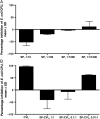Loss of Innate Host Defense Following Unprotected Vaginal Sex
- PMID: 26464206
- PMCID: PMC4747617
- DOI: 10.1093/infdis/jiv488
Loss of Innate Host Defense Following Unprotected Vaginal Sex
Abstract
Background: Multiple host defense mechanisms protect the female genital tract from pathogens, but the impact of sexual intercourse on defense is unknown.
Methods: As part of a hypothesis-generating study, 17 women provided cervicovaginal lavage (CVL) specimens at baseline (all had abstained from sexual intercourse, masturbation, and vaginal product use for 72 hours prior to screening), 2-6 hours and 10-14 hours after vaginal intercourse with a male condom, and 2-6 hours and 10-14 hours after vaginal intercourse without a male condom (5 visits total, including the baseline visit). Vaginal pH, concentrations of immune molecules, and antimicrobial activity at postcoital visits were compared to baseline values.
Results: Vaginal pH and the transforming growth factor β1 level increased, but human beta-defensin 2 (HBD-2), HBD-3, and interleukin 8 levels decreased after unprotected sex. Median Escherichia coli inhibitory activity in CVL specimens decreased significantly from baseline at the visit 2-6 hours after unprotected sex (63% [range, -34% to 99%] vs 5% [range, -51% to 100%]; P = .02) and remained low at the visit 10-14 hours after unprotected sex (6% [range, -19% to 92%]; P = .02). Pooled human seminal plasma enhanced E. coli growth in vitro in a dose-dependent manner and, when added to CVL samples with high anti-E. coli activity, reversed the inhibition.
Conclusions: Unprotected vaginal sex results in a reduction in endogenous anti-E. coli activity, which may reflect, in part, enhancement of bacterial growth by seminal plasma. This finding may contribute to the risk of E. coli vaginal colonization following sexual intercourse.
Keywords: E. coli; female genital tract; human beta defensins; mucosal immunity; semen; sexual intercourse.
© The Author 2015. Published by Oxford University Press for the Infectious Diseases Society of America. All rights reserved. For permissions, e-mail journals.permissions@oup.com.
Figures




References
-
- Cole AM. Innate host defense of human vaginal and cervical mucosae. Curr Top Microbiol Immunol 2006; 306:199–230. - PubMed
-
- Valore EV, Park CH, Igreti SL, Ganz T. Antimicrobial components of vaginal fluid. Am J Obstet Gynecol 2002; 187:561–8. - PubMed
-
- John M, Keller MJ, Fam EH et al. . Cervicovaginal secretions contribute to innate resistance to herpes simplex virus infection. J Infect Dis 2005; 192:1731–40. - PubMed
Publication types
MeSH terms
Grants and funding
LinkOut - more resources
Full Text Sources
Other Literature Sources
Research Materials

